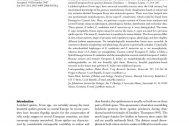Rok
2008Autoři
RNDr. Milan Řezáč, Ph.D.prof. Mgr. Stanislav Pekár, Ph.D.
Druhy
Eresus kollari Rossi, 1846 VUEresus moravicus Řezáč, 2008 CR
Eresus sandaliatus (Martini & Goeze, 1778) CR
Obsah
Ladybird spiders (Eresus spp.) have attracted scientific interest since the 18th century, but taxonomical knowledge of the genus is unsatisfactory. Early classification based on colour and size variation divided European Eresus into numerous species. These were later lumped into one predominant morphospecies, Eresus niger/E. cinnaberinus, which could be found from Portugal to Central Asia. Here, we perform a major revision of Eresus from northern and central Europe using morphological, phenological, habitat, distribution and molecular data. Three species, Eresus kollari, Eresus sandaliatus and Eresus moravicus sp. n. were distinguished. The name E. niger (originally Aranea nigra) cannot be used as the name A. nigra was used for a previous spider species. The name E. cinnaberinus is considered a nomen dubium. The three species differ in size, colour pattern, shape of prosoma and copulatory organs, phenology, and have slightly different habitat requirements. No morphologically intermediate forms were recorded. In contrast to distinct morphology and phenology, the genus is genetically complex. Genetically, the mitochondrial haplotypes of Eresus sandaliatus and Eresus moravicus sp. n. are monophyletic, whereas those of Eresus kollari are paraphyletic. Eastern central European Eresus kollari is likely a hybrid lineage between Eresus sandaliatus and the monophyletic western central European Eresus kollari. Because eastern and western European Eresus kollari are morphologically and phenologically indistinguishable, we did not formally split them. However, detailed population-based research in the future may partition Eresus kollari into additional species.



